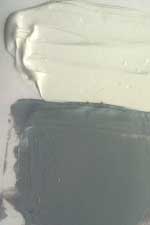- Color Name
- Flemish White
- Brand
- Blue Ridge
- CI Name
- PW3
- Composition
- Lead Sulphate

The first time I used this white, I knew that I had really found something. It has a long ropey quality that’s more like the hand mulled paint I made. Look at the brushwork of a lively Frans Hals to see what this can do. At the end of a stroke, the paint can pull away with the brush but break and fall back. This somewhat sticky nature makes it possible to paint a glint of light, as an example, without the brush ever touching the canvas. It’s not nearly as opaque or chalky as Titanium White so it’s a good choice for a mixing white. I used to use Zinc white, because it makes clean tints. Zinc however has serious embrittlement problems. Lead whites have historically been good film strengtheners in oil. On another historical note, it seems that this pigment has emerged from history because lead carbonate is hardly manufactured anymore.
I get Flemish White in quart cans and tube it up, usually with about 25% M. Graham Quick Drying Titanium White. This gives it more opacity and quicker drying, not that it’s a slow dryer by itself.